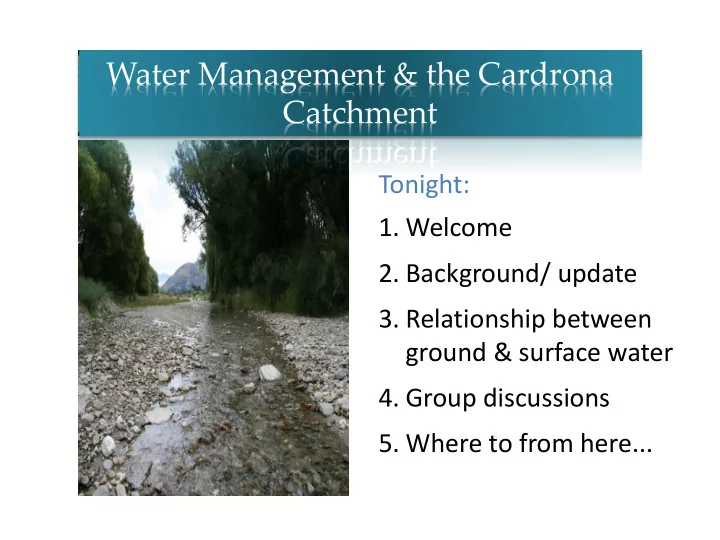

Water Management & the Cardrona Catchment Tonight: 1. Welcome 2. Background/ update 3. Relationship between ground & surface water 4. Group discussions 5. Where to from here...
Process Workshop #1 (June 2010) - catchment values Workshop #2 (February 2012) – scenarios / futures Workshop #3+ – potential regime Consultation paper Notify proposed plan change RMA process Changes put into effect
Update • Clear messages from community - Last workshop held 2010 - Community values / ‘wants’ • Irrigation and viability of farming • Protection of aquatic ecosystems • Recreation & aesthetics • Protection of water resource for all • Since then...
Why integrated water management? • Studies show all sources of water are interconnected and need to be managed as one • PC1C effective April 2010 – Local water source / local use – Efficiency expected – Nature of taking – when, how often, amount • Current sources of water: - Cardrona River (100% allocated) - Cardrona Alluvial Ribbon Aquifer (100% allocated) - Wanaka-Cardrona aquifer (dependent of maximum allocation volume decided) - Clutha River (allocation available)
What does this mean for water takes? • Main stem takes - minimum flow & rationing • Cardrona Alluvial Ribbon Aquifer - managed as surface water - minimum flow & rationing • Tributaries - connected tributaries (naturally flows to main stem) – minimum flow & residual flows & rationing - unconnected tributaries (naturally disconnects from the main stem) – residual flows if in-stream values exist • Unconnected groundwater - maximum allocation volume
So what did the science show us?
Group discussions / feedback
Scenario 1: continuity Scenario 2: targeted Scenario 3: no continuity Significant reduction in Flows targeted for critical Minimal reduction in water water available for irrigation times. Impact on for abstraction (similar abstraction irrigation depends on levels. situation to now) Water along length of Water in river at key times for River dry from the Larches to river all year for river river based tourism e.g. early SH 6 Bridge impacting on based tourism summer. Upper catchment river based tourism in lower flows unaffected river Water along length of Targeted e.g. water in river for River dry from the Larches to river all year for river based recreation SH6 bridge impacting on recreation early/mid summer. Upper recreation in this reach catchment flows unaffected Close to optimum flow for Maintains flows for trout Trout migration limited most juvenile trout. Enables migration at key times years trout migration every year Aesthetic - flowing river Aesthetic - flowing river at Aesthetics - river flowing maintained at all times targeted times of the year above Larches /below SH6 bridge. Dry at Ballantyne Road bridge Increase in aquifer recharge from river relative to minimum flow levels
Where to from here... Workshop 3 – Suggested option Consultation paper (draft) Notify proposed plan change RMA process Changes put into effect
Recommend
More recommend